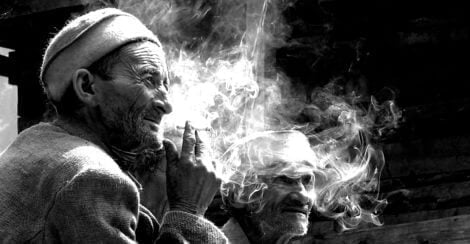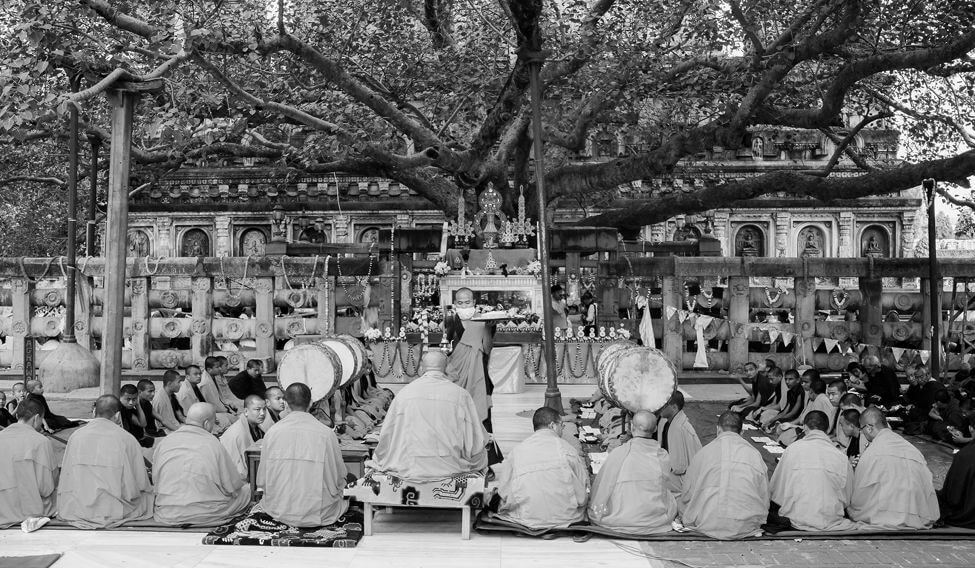Malana मलाणा , is an isolated village of Himachal Pradesh, having their own parliament and constitution.
The people of the village consider themselves Aryans, so special you can not even touch them or their belongings. And they grow marijuana – it is everywhere. Discover Myths, folklore and taboos of Malana.
In this Article
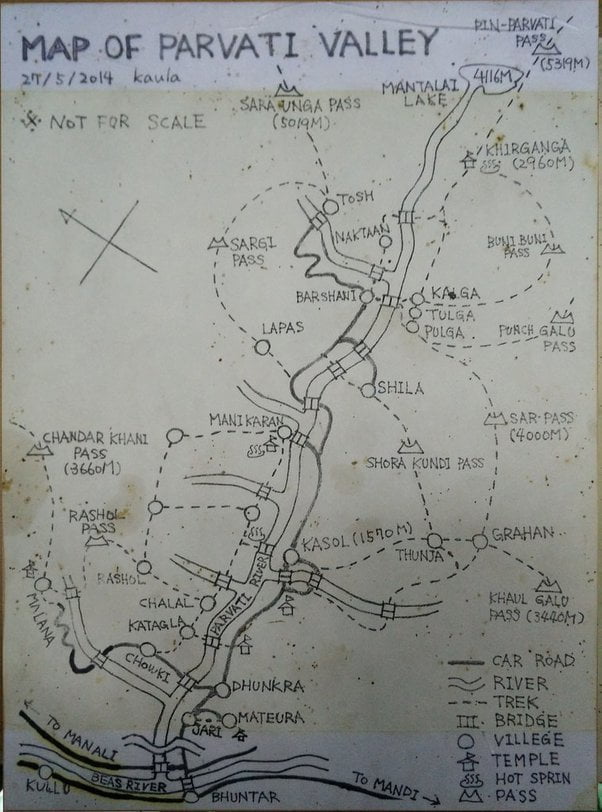
From Kasol, Malana is about 21 km. A jeep carries us over the first 18 km, and then we trek uphill.
The climb up the slope is steep, tough but short.
Malana is located on a narrow plateau, high on one side of a wild and remote glen that abuts the river Parvati in the Kullu valley of Himachal Pradesh.
The Malana Nullah, which flows through the valley, comes from Deotibba, a 6000 meter or 20000 feet, snow-covered peak that overhangs the glen and the village.
“Touch the temple or a local and pay a Rs 1000 fine”,
we are told on our way to Malana. In the far north of India in the Himalayas, in the Kullu Valley, under majestic peaks, there is a village of about two hundred houses called Malana. They call some neighboring villages cousins, like Ghor or Gohar, Rasol and Tos or Tosh in the West, where such a taboo also exists.
This unique settlement of about 1000 to 2000 inhabitants, is self-governing with a system that is considered democratic, working according to the guidance of their powerful deity Jamlu Devta.
MYTHS, FOLKLORE & TABOOS OF MALANA
Jamlu Devta Rishi

Jamlu, also Jamalu Rishi, is believed to dwell in this part of Himachal Pradesh, gradually forming a community and making rules and regulations for his devotees.
The title “Rishi” is added after Jamlu Devta’s name because he meditated for 35 years in Devropa, which is a sacred place. Devropa, today Malana, being the place where gods live.
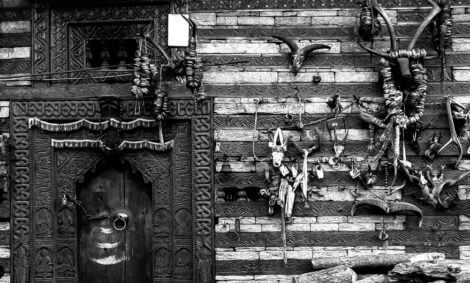
We head straight for Jamlu Devta’s temple, that was built in Kathkuni style. It is richly decorated with wood carvings depicting flora, fauna and dancers.
The presiding deity within this wooden temple, is veiled behind the facade and adorned by the horns and skeletons of animals sacrificed to him.
However it is only the people of Malana who have access to the sanctum. We read a sign:
NO TOUCHING – PHOTO OF JAMLU RISHI 1000 RS FINE
Akbar and Jamlu Rishi
Legend has it, that the residents of Malana are the descendant of Aryans, and they acquired their independence during the Mughal reign.
The story goes that – Emperor Akbar’s tax gatherers charged tax from a man in Delhi who had been given a gold piece from Jamlu’s treasury in Malana. Akbar was immediately struck with leprosy.
He sent his men with a golden horse to Jamlu Rishi, and it is said that the horse is still in Malana, in Jamlu Devta’s treasury.
Jamlu Devta was pleased and Akbar was cured.
Akbar never collected any tax from the village of Malana thereafter. Every year this incident is enacted at Malana in the festival of Fagli or Phagli, and the idols are brought out from inside Jamlu Devta’s temple.

Fagli – The village fair
As the name suggests, Fagli or Phagli fair begins during the month of Phalgun (February and March). Fagli is celebrated in most of the villages of Kullu valley, but it holds a very important place among the people of Malana. It depicts the victory of good over evil and shows the struggle between Gods and demons for supremacy. Ultimately, God emerges victorious.
Fagli is celebrated by the people in the Malana village in honor of their Devta – deity Jamlu. Women of the village act a traditional dance in the courtyard of Mata Ambika and Mata Renuka manifesting acts of devotion to Jamlu Rishi.
A person is disguised as a demon by putting a mask on his face and tying branches and green cannabis leaves around his body. God is represented by a ‘Gur’ (God’s spokesman). They perform dances called Deo Khel (acted upon by the Gur) and Raksh Khel (performed by the person who is impersonating the demon).
The demon was known as ‘Tundi Raksh’ who used to trouble the people living between Malana and Archhandi villages. He was finally killed by Manu Rishi and Shandalya Rishi. To commemorate this event, the fair is held in Malana, Jana, Soil, and Halan villages and in all the temples of Jamlu Devta.
Malana and the Akbar – Jamlu Legend
Malana and the Akbar-Jamlu Legend, written by English historian Young, G. M., in 1916, holds a fascinating account of the ceremony which takes place in the early spring of each year at which a minute equestrian statue of the Emperor Akbar is produced, and worshiped. Young tells us:
“The statue of Akbar was then placed on the table rock and the pujari did obeisance to it. From his bundle he produced twelve more very small images of
horses and elephants, evidently the rest of Akbar’s gift.
These he grouped behind the statue handling them with much show of devotion and pressing them against his bowed forehead before he put them down one by one.
Over Akbar and the attendant images he fixed the big silver umbrella and round them he placed all the large statues which had been carried up by the elders. The stone was censed once more, flowers were laid over Akbar and the other images, and branches of juniper waved like fans above them. A libation probably of ghee was also offered…”
Animal sacrifices are made and silver statues of horses, elephants and deer, a large silver umbrella of the kind used by Kullu deotas, and a smaller one which was fitted into the back of a very large silver stag are part of the ritual.
Young recounts:
“All these images are said to be offerings of pilgrims, or made by the Malana men from such offerings. The pujari himself carried a closely wrapped bundle containing the statuettes presented by Akbar.[…]”
In this book: Kulu – the Happy Valley. 1956, another version of the story is given – Emperor Akbar’s connection with this remote and almost inaccessible glen may be founded on a sub-stratum of fact. Briefly, the story is as follows :
A sadhu on a visit to Malana, received two piece from the treasury attached to Jamlu’s temple. Eventually, after reaching Delhi, these piece were confiscated by official tax gatherers, as poll tax, and deposited in the Emperor’s treasury.
Shortly afterwards, Akbar became afflicted with leprosy and was informed by Brahman advisers that an insult had been offered to Jamlu and that the piece must be restored if he wished to recover.
A search of the treasury being made the two piece were found, miraculously stuck together, and Akbar was told to take them to Malana. A compromise was, however, effected by the Emperor sending the piece and, in addition, a golden
image of himself and images of his horses and elephants in gold and silver.
On receipt of these tokens of conciliation the wrath of Jamlu was appeased and the Emperor recovered from his leprosy.
A ceremony in commemoration of this event is held every year a t Malana in Phagun, when the images are removed from the treasure house and taken to a grove above the village – the spot at which Jamlu received the homage of the Emperor.
According to Young, however, who was present at this ceremony in 1916, also Akbar is worshiped, though originally (by proxy) he was a suppliant at the shrine of Jamlu.
Alexander the Great
The green eyes and sharp features of the locals lay claim to being descendants of the Aryan army of ‘Alexander – The great’ of Greece.
Popular folklore holds that Malana villagers are descendants from the remnants of Alexander’s Greek soldiers who chose to stay back after his conquest in 326 BC. The soldiers of Alexander the Great’s army took refuge in this isolated village after being wounded in a battle against Porus, ruler of Punjab.
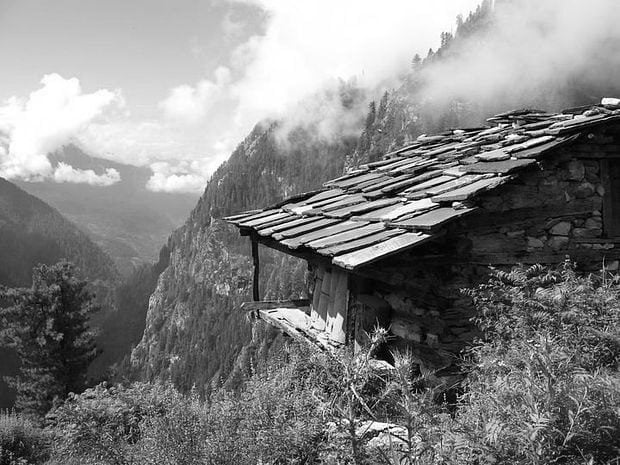
This is also supported by the local folklore of some carvings, showing soldiers on the wooden houses.
Thus Malana is also known as the “Athens of Himalayas” or “Little Greece.”
Ra-Deo
According to oral tradition, Malana was founded by a group of hunters. People from Malana have been described as Nágwanis, with ancestry deriving from the Nagoni in Kothi Nagar, the Sarwálas from Sar in Kothi Kais, the Thamiáni from Thale in Bárágarh Kothi, the Pachiáni from Pos in Kanáwar Kothi, and the Dharáni from Dhárá in Kais Kothi. They have been collectively called Ra-Deo.

Although the early history of Malana is obscure, the tradition associated with Jamlu in Malana beyond the Chandrakhani range (Chaini above Banjar, the villages of Dandaru-Dandasu and Shisa and Sipaha in Kullu District, and the village of Hansa in Spiti valley) points to the existence of ancient and close ties between these villages.
The kingdom of Spiti
Incidentally, these villages are located in a geographic area that once formed the kingdom of Spiti under the Sen dynasty of Bengal around 765.
It is hypothesized that Spiti remained a theocratic kingdom under the Sen rulers, upholding the sovereignty of Jamlu, as indicated by traditions prevalent in Hansa, where Jamlu is regarded as the king and antiquated frescoes are still enshrined in the basement of a monastery in the village.
However, a detailed account of the early history of Malana is not palpable from these hypothetical records.
The written records trace the history of Malana only to the seventeenth century AD (Gore 1972; Young 1916). It is likely that Kullu, like most of the other hill states, came under Mughal control during Emperor Akbar’s reign, and a reference is made to the association of Emperor Akbar with the temple of Jamlu in the village of Malana (Young 1916).
Malana on an ancient trade route
Historical accounts seem to indicate that the first settlers in Malana were from the vicinity, mainly from the valleys of Parvati and Beas in Kullu District or from Kinnaur District.
An ancient trade route extended from Bashahr (a princely state in pre-independence India) across the head of the Parvati valley with one branch passing through Malana. The Kanauris of both Bashahr and Parbati valley used to trade with the Tibetans, and Malana was probably one of the several Ladhaki advance posts for protecting the flank of this route during the Badani dynasty in Kullu.
FOLKLORE: Customs and Traditions
Entering the village we see a sign:
touch the temple or a local and pay a Rs 1000 fine.
We follow a stone path, dotted with various sacred stones, that passes through the center of the village.
The houses are built of wood and stone with two or three floors and each floor has a specific function, the ground floor is called Khudang and is used as stables for livestock. The first floor, Gaying, is used as a warehouse for food, clothing and firewood. The top floor has a large balcony and is the residential area.

Kanashi language
A little girl carrying a hay bale, wait it is marijuana on her shoulders shouts to us :
don’t touch – don’t touch.
Her native language is Kanashi. The language of Malana, does not resemble any of the dialects spoken in the Parvati valley where they speak languages belonging to the Indo-European family. Kanashi has been classified as a Sino-Tibetan language.

This figure shows a classification of Kanashi within the Sino-Tibetan, as well, as Kinnauri and Bunan. Both languages show closely related points of comparison in the description of the Kanashi numeral systems, together with Zhangzhung, an extinct West Himalayish language.
Malanis speak a language that has no script, Kanashi has been declared one of the endangered languages of the world. Although the inhabitants claim to be descendants of Alexander the Great’s soldiers, there is no evidence of lexical links with Greek and Macedonian languages.
Most Kanashi speakers understand Kullu Pahari and Hindi, and many younger
villagers and children speak a mixture of Hindi, Kullu Pahari and Kanashi.
Even locals who never leave Malana are exposed to Hindi, Kullu Pahari and English on a regular basis, since the introduction of satellite television, internet and mobile phones in the village. Influx of tourists and workers from Bihar and Nepal expose the locals to their languages as well.
Kanashi is not the language of media, education or employment, but it is the medium of communication among its native speakers in their private and religious spheres.
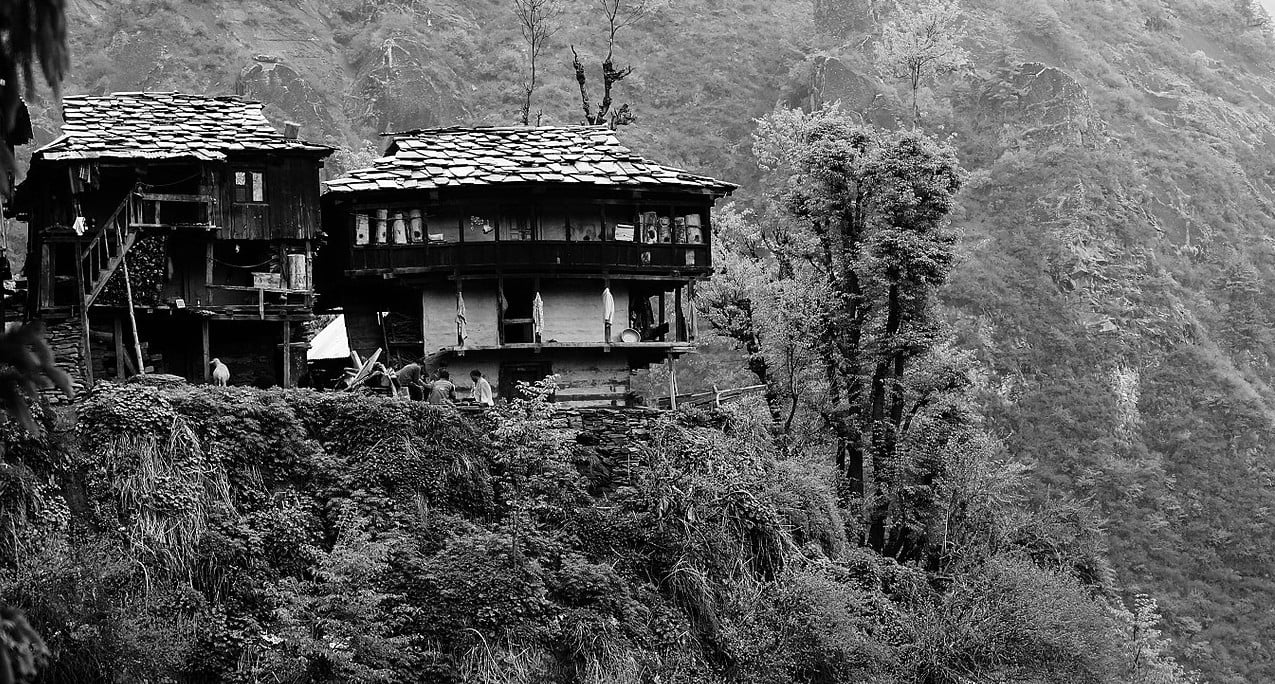
Old village folk watched us, sitting on a stone platform in the village main square, while serenely gurgling on their Chillums. The central square, is the place where the village council makes its decisions, just as in ancient Greece.
DEMOCRACY
Malana village doesn’t have any police or court; they have their own laws to solve any problem. It thus has an Upper house and a Lower house where rules and regulations are formulated.
The Malana administration is based on religion and the elected members are selected among the inhabitants of Bhandaria which are assigned the tasks of collecting tax on the land area, which falls under the jurisdiction of the village shrine, deposit all revenue in the sanctuary treasure, keep the profit and loss account, collect and deposit the offers, arrange funds for functions and organize the festivities, hold the symbols of Jamlu Devata during religious processions.
The priestly office is hereditary. Jamlu is the deity who is considered lord of the village. His courtiers are elected and raise funds for the maintenance of civic services by revenues produced by the village land, strangers who graze their cattle, cash contributions from devotees, gold and silver horse and visitors offers.

The parliament of Malana is a bicameral parliament, comprising of a lower house called Kanishthang and an Upper house called Jayeshthang.
There are 11 members in the Upper House (Temporary-8, Permanent-3). The 8 members are from 4 wards who are elected and called ‘jethra’.
Out of the 3 permanent members:
- one is the village head who is also the principal administrator of the Upper house and works according to the orders of their powerful deity ‘Jamlu Devta’.
- The second member is a priest whose main responsibilities include offerings to Jamlu Devta and make people follow the religious customs.
- The third member is known as ‘Gur’ or ‘Goor’ who is believed to have direct connection with the deity. At times it is believed that the deity himself chooses a person and enters into his body, following which the person starts shivering and then predicts future of anyone. That particular person is called ‘Gur’ and thus is not elected by the villagers. There may also be two Goor, or none, as happened after the 1985 death of Madgu that was not replaced (due to bad influences of evil forces). Tradition has it that when a Goor is recognized as such, you wear a white hat and let your hair grow. On occasion the Goor, in a rite of shamanic type, dance in ecstasy possessed by the spirit of Jamlu Devta. On these occasions he hears the complaints of citizens and expresses its opinions.
The other members are elected. The justice is self-managed. Judgments are discussed first from the bottom board, until it reaches unanimity. They are then issued by the High Council and especially, monetary fines. Sometimes decisions are re-discussed and after weighing the interests of the village, the pros and cons, are changed. Anyone who does not accept the verdict is driven away from the valley. The most severe sentence on the theft of sacred objects, provides that the offender be tied to a stone and thrown off a cliff.
In the earlier days none of the cases of Malana went to the court of Kullu but recently few cases related to drug trafficking have entered the court.
Animal sacrifices
When there is an upcoming decision to be made about an unresolved conflict between two parties, the right foreleg of two lambs are cut about one and a half inches deep, stuffed it with poison and sewn right back up.
Each lamb is assigned to a party and whichever lamb dies first, that particular party loses the judgment. This is done because they believe the decision is made by their Devta.
Animal sacrifice as part Phagli
Again it is Young,1911, describing us his view on the Phagli sacrifice at Jamlu’s stone in the sacred grove:
“Then followed the sacrifice.
A white ram was led up, anointed and garlanded by the pujaris. It was then laid on its back and its forelegs and hind legs tied together.
There was no “hallaling” of the sacrifice. Instead the pujaris seized the ram together, each holding two feet and keeping its back on the ground, dragged it in this way round and round the stone, every few seconds lifting it high above their heads and battering the unfortunate beast with all their force down against the rocky ground.
At this horrible sight the Negi turned away with an exclamation of disgust, and I noticed that quite two-thirds of the Malana men came away from the rock and refused to watch.
When the ram was nearly dead, the pujaris took it away among the rocks, cut it open and extracted the heart, which they offered to Akbar.
After this one of the pujaris began carving up the ram, while the other wrapped up the smaller images again without any ceremony and handed the larger ones back to the elders.[…]”
Kaika ceremony
At intervals of every few years (the actual interval depending upon the will of the god, declared by the Gur ) , on the first day of Bhadon, a very large fair is held at Malana at which special ceremonies, including the kaika, is performed.
This ceremony of kaika is, perhaps a modern survival of and the nearest approach to the traditional tales of human sacrifice still current in some out-of-the-way mountain regions.
The Nar, (a special caste) is obtained from Manikaran and takes upon himself the evil deeds of the community. He is then assumed to he dead and is placed upon a bier and paraded round the assemblage. Finally, as at other similar ceremonies at Shirrar, near Raison, and at Nirmand, in outer Saraj, he is brought to life again.
A woman from the same village is also consecrated to the god and, though not denied cohabitation with men of her choice, she remains unmarried. ( Kulu – the Happy Valley. 1956)
Environmental regulations
Subjected to their rules, it clearly briefs them as highly environment-friendly,

- its prohibited to chop down trees for any purpose,
- even fixing a nail in its stem for that matter;
- villagers are only permitted to collect dry wood or twig as fuel;
- hunting is only allowed in certain period of a year with permission of village council, hunter is rewarded if one kills a bear but then its skin, according to the rule book, needs to be submitted to the temple authority.
Taboos – DON`T TOUCH
In this democracy there are also rules to follow for us. The people are friendly, but we need to keep our distance and not touch anything in the village.
Any visitor touching a resident must pay a fine of 1000 rupees.
Anything which is touched by a visitor is purified by the blood of a sacrificed animal, usually a lamb, a goat or a goose. We are also not allowed to take photographs of the religious monuments of the village. Also it is not accepted to enter the temples. We respect that.
Malana Cream
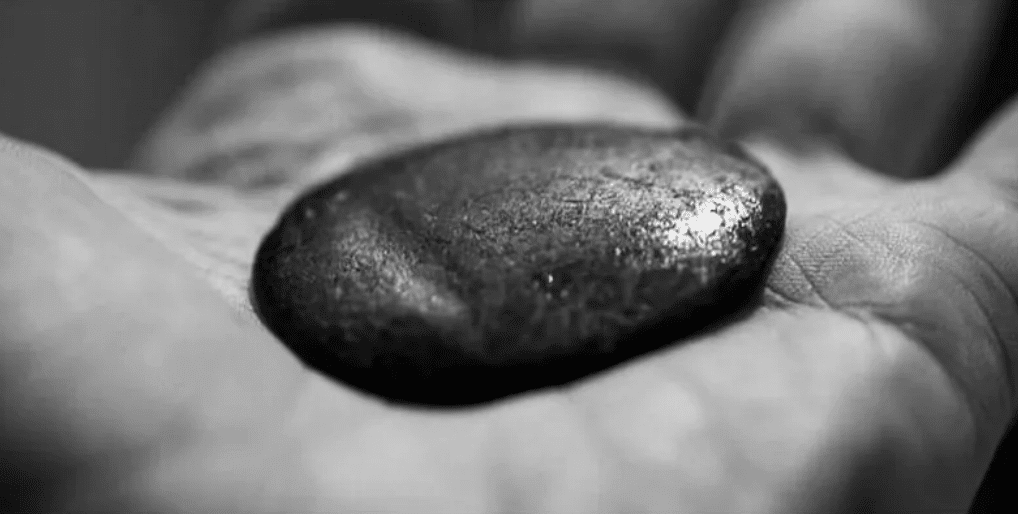
The Kullu District in the Himachal Pradesh State of northern India is home to an ancient culture of hand-rubbed hashish.
Local legends tell us that Shiva and his wife Parvatti brought ganja seeds to the Kullu valley, took up residence there, and smoked the chillum. In South Asia, the chillum is a straight tapered pipe, usually made of clay or stone, that is held vertically when smoked.

The traditional charas-producing areas lie in the Parvatti Valley near Malana and in the Kullu Valley by Manali. The Hippie Hashish Trail reached the remote Kullu Valley after the Himalayan Foothill areas nearer Katmandu had been explored. The ganja fields of Kullu thrive at altitudes from 3200 to 3800 m.
The use of ‘Bhaang‘, cannabis (Cannabis is the genus name for the marijuana or hemp plant.), has been an integral part of the lower areas of the Parvati valley from medicine to footwear.
Malanis bartered ghee, wool, honey and game birds with the other Kullu villages for salt, food and tools. Today, nobody barters because a thriving illegal charas trade has made the villagers cash rich.
Two different types of ganja grow here, from which two distinctive kinds of charas are made. Wild ganja is called jungli. Charas made from jungli is the traditional charas of Kullu, but it is becoming scarce.
Cultivated ganja is made into charas called begij. The rapid growth in hashish popularity during the 1960s and 1970s resulted in increased plantings of ganja fields. Begij is now the most common charas also called Malana cream.
At some point in the 70s, the cultivation of cannabis was introduced. Johnny tells us about Italian hippies from Sardegna – Cagliari, that have bought some quality Indica plants to Malana. Legend has it, that they escaped visa controls and where hiding in Malana, a secluded place at the time. These pioneers would plant weed choosing the sunniest mountain slopes. Also they would share their knowledge about cultivation and how to rub the plant.
The wet, windy and sunny weather around Malana is excellent for cannabis cultivation. Resin is produced by various parts of the plant, but it is most heavily concentrated on the buds of um-pollinated female cannabis flowers. Female plants are grown and harvested for their resin, that will give high quality charas (hashish).
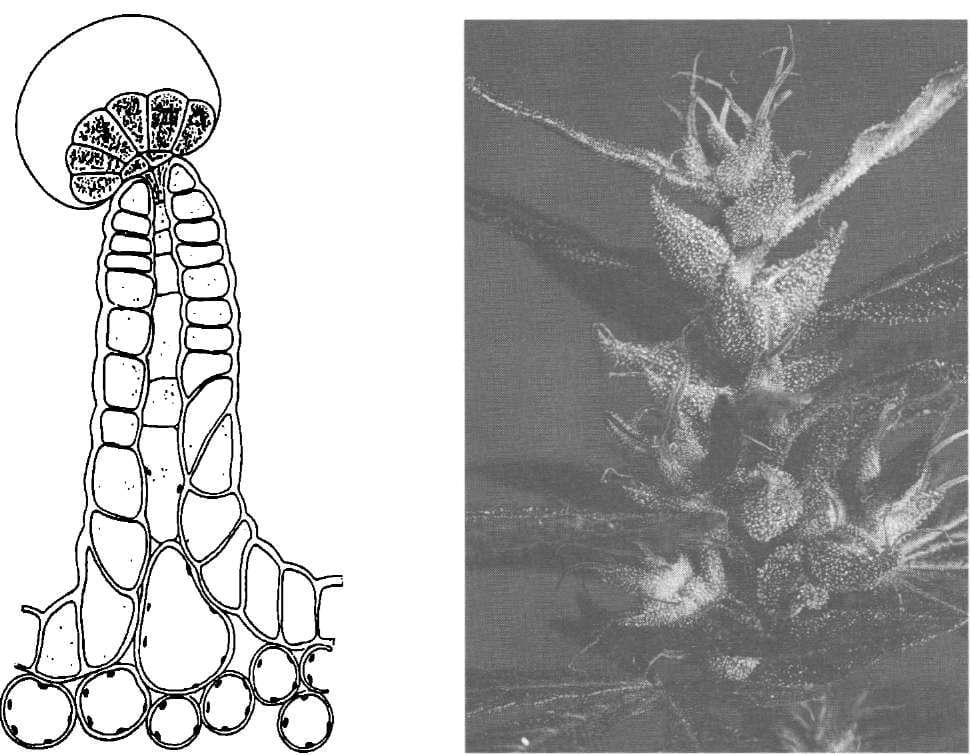
Cannabis resin acts as an external immune system and communication network for the plant. The six types of sticky trichomes present on the plant offer numerous benefits, including protecting the plant from pests, infections, herbivores, and damaging UV rays.
Johnny knows: “Especially the cold nights would invite the plant to throw out resin to protect the flowers.” The higher the altitude, the plant grows, the more resin is produced.
Franco Casalone

Malanis tell the story of Glenu, an Italian who was hiding (visa issues) in the village and taught them how to rub the cream – the oily, cleaner and more potent charas suitable for an international market.
The valley’s most legendary long-term Italian resident is Franco Casalone a cannabis activist and the author of several books on cultivation and legalization. He had visited India several times in the late 1980s and early ’90s, and then, in 1996, had come to the Malana region, where he lived in a shelter built into the lee of a giant boulder. He stayed for a decade—where he became, as he’s been called,
“ the greatest European expert in traditional charas production techniques.”
The village now is famous the world over for producing ‘Malana cream’, considered one of the best quality charas in India. Generally it is more ‘creamy’, or clay-like, as compared to that produced in other parts of Bharat.
Hand rubbed Charas
The Himalayan Foothills are rainy throughout much of the late summer and fall when the local plants are rubbed for hashish. The rubbing is done when the plant has the right maturity and color, but is not to dry, Jhonny knows. As for the height it is grown till 3500m (11482.94 Feet) and it shall be this charas that is the strongest.
Only the healthy flowers, with no lice or spiders are rubbed, the small leaves and seeds are taken away also. Vine plants are to be plucked, as they give a unwanted taste to the charas. Obviously the male plants are to be taken off the field before maturation.
The creaminess is determined by the amount of plant material that gets collected along with the resin. Lesser plant material makes the resin softer and smoother – creamy. All this is determined also by the experience and patience of the worker growing, harvesting and rubbing it.
The hash unleashes a complex blend of aromas, a pleasant mix, malty sweet, fruity, and hashy notes, some say the cream tastes ghee, – clarified butter like.
Anyway the taste and smell depends on the environment, it grows in – like neighboring plants – corn makes it yellow, mango tree – fruity, citronella
– lemony and pines – woody.
The high is cerebral – clear, clean, stimulating – building to a heady plateau as more is smoked.
Medically, the “Malana” strain has been known to be of particular benefit for those suffering from fibromyalgia. Helping relieve associated symptoms such as insomnia and nausea.
Malana cream became an international brand. Hashish production grew as a home industry for each household. The high quality Cream so produced, fetched fabulous prices. In fact, in 1995, Malana Cream was adjudged one of the finest hashish smokes at Cannabis Cup, Amsterdam.
As its fame grew, Malana soon became a center for recreational drug tourism, with smokers flooding the valley, as they continue to do today.
Historically, hand-rubbing was followed by the more efficient technique of drying whole plants, and then collecting their resin by sieving.

If the supply of ripe plants is large and the time and physical conditions are not suitable for drying the plants, then hand- rubbing becomes a practical method for making hashish. Hand-rubbing is also appropriate for collecting resin in humid climates where drying and sieving are difficult, like in Malana.
The thick layer of fresh rubbed resin sticks to the rubbers, about 4 to 5 grams are rubbed in a days work, even more if someone cleans the plants for rubbing. Also, removing the precious resin from the hands is an arduous task, as the sticky resin can take of skin parts in the process.
Charas is illegal
While growing cannabis was part of the traditional crops in much of Kullu valley, it having been declared a contraband and its growing banned is resented by the villagers. From time to time they have been agitating to get marijuana cultivation legalized.
Villagers now produce this world- renowned Hashish out of its plantations, grown despite the laws of the Indian government. The police at times try to go and destroy the crops but it grows naturally and at a great length due to which they fail in this operation. Cannabis is grown in mountain fields around the villages and the hilly slopes of Kullu and Parvati valley are filled with weed – properly cultivated as we know of farms or estates.
Before leaving, we see Malana men gather in groups or loitering in the warm sunshine, some smoking and some taking part in an administrative discussion in front of the main temple. We have not seen woman smoking, but Johnny tells us, that once a year, at harvest festival woman will roast the seeds and eat it – spreading joy and laughing all night long.
Woman are hanging clothes, grandma is spinning yarn using a spindle, anther one is weaving. On the balconies woman and children are rubbing buds. Younger siblings are holding a goat on a string and joking.
The village is an enigmatic as we had heard. Malanis admire their culture, customs and religious beliefs. Though some traces of modernization are visible, like a bank and satellite bowls on the roofs.
Yet again we read a sign.
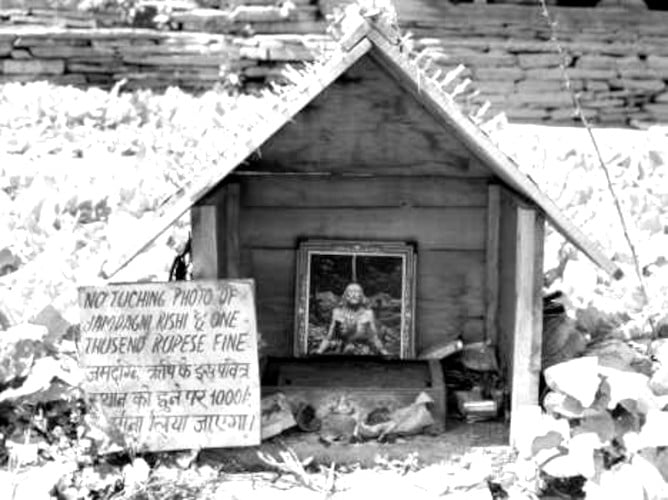
NO TOUCHING PHOTO OF JAMLU RISHI, ONE THOUSAND RUPEES FINE
“Jamlu Devta के इस पवित्र स्थान को छूने पर 1000 जुर्माना लिया जाएगा।”
Note:
Johnny, an Italian friend we met in Goa, knew Glenu and Malana, he said:
“Malanis touch non Malanis and are touched, when outside of Malana.”
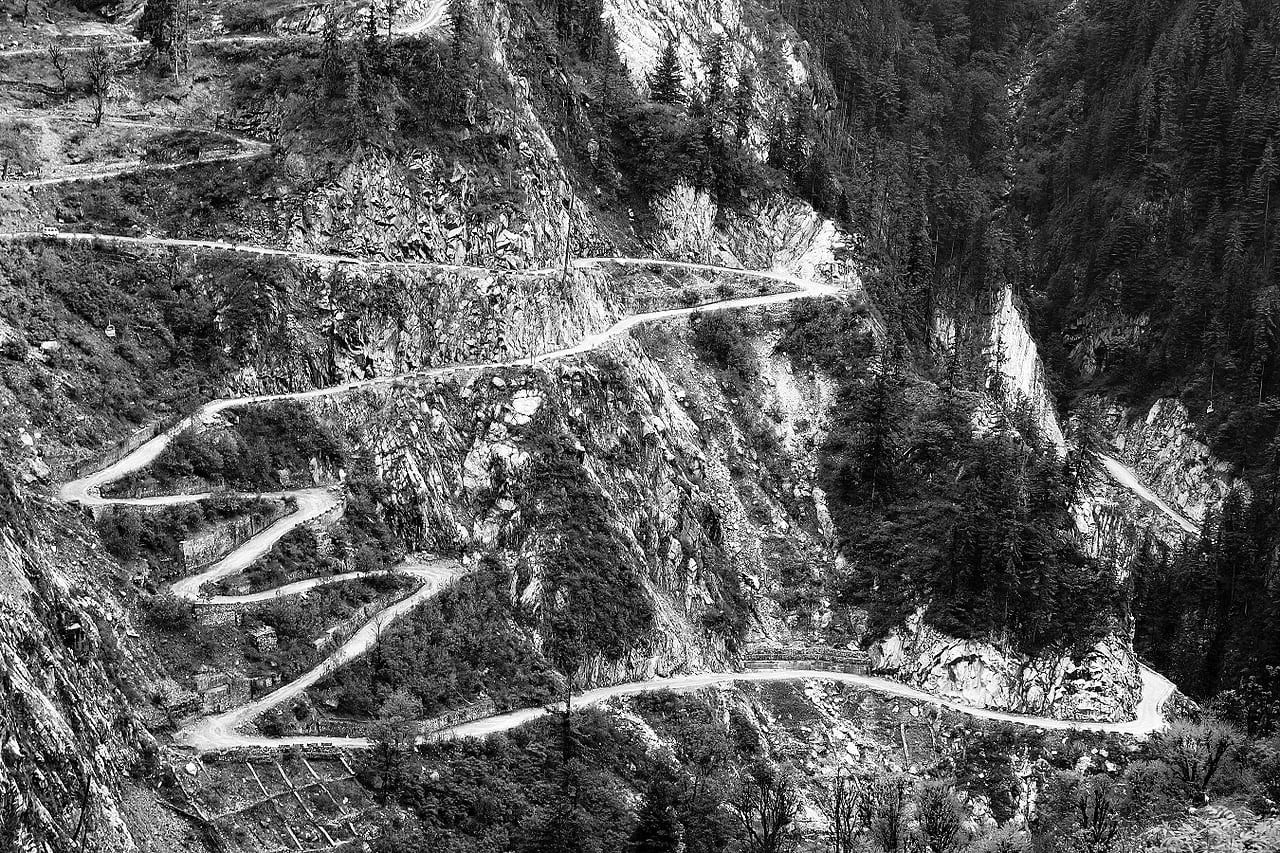
– There is a thick smell in the air, herbal… burned pine wood, or is it vanilla like…These high-altitude location, along with powerful genetics, create the perfect canvas for Mother Nature to create her magic.
~ ○ ~
Keep exploring:
Works Cited & Multimedia Sources
- Explore INDIA with earthstoriez.
- Gore, Frederick St. John Lights & shades of hill life in the Afghan and Hindu highlands of the Punjab: a contrast. 1895. https://pahar.in/pahar/Journals/Panjab%20Historical%20Society/1918%20Journal%20of%20the%20Panjab%20Historical%20Society%20Vol%205%20to%208.pdf
- Gore, Frederick St. John Lights & shades of hill life in the Afghan and Hindu highlands of the Punjab: a contrast. 1895.
- https://core.ac.uk/download/pdf/232745844.pdf
- Young George Malcolm. Journal of the Panjab Historical Society, 4 (2), 1916.
- https://ethnoflorence.wordpress.com/2022/02/11/paldi-fagli-malana-%E0%A4%AE%E0%A4%B2%E0%A4%A3-village-%E0%A4%AE%E0%A4%B2%E0%A4%A8-%E0%A4%B9%E0%A4%B2%E0%A4%B8-%E0%A4%B9%E0%A4%AE%E0%A4%9A%E0%A4%B2-harlala-mask-dance-festival-three-rakshasa-masks-an/
- The story of Manala. http://www.aheadofdemocracy.com/story-of-malana.html
- Abhishek Madhukar. The Untouchables – Malana, India. 2003. https://web.archive.org/web/20150930194714/http://www.bootsnall.com/articles/03-06/the-untouchables-malana-india.html
- Clarke, Connell Robert. HASHISH! 1998.
- Documentaries: 1. Malana: Globalization of a Himalayan Village and 2. Malana : A Lost Identity
- Judhajit Roychoudhury. Malana: oldest democracy, hashish and myth.
- Kalyan Panja. The Secrets of the Mysterious Village of Malana. 2017.
- Kamal Thakur. Malana – World’s Oldest Democracy – Kullu .2012. kullutourism.com/malana-village-kullu-trek.php
- Kullu Valley – The Land of Folklore and ‘Tharah Karadus’. The OK Travel. http://theoktravel.com/kullu-valley-the-land-of-folklore-and-tharah-karadus/1059/
- Malana Village and Drug Tourism. https://dexventure.com/2017/12/24/malana-village/#more-314
- PICS: मलाणा(Part-1)- यहाँ के लोग मानते है खुद को सिकंदर के सैनिकों का वंशज, यहाँ नहीं चलते भारतीय कानून
- मलाणा (Part-2)- यहाँ अकबर ने जमलू देवता से मांगी थी माफ़ी, इसलिए होती है पूजा
- मलाणा : हिमाचल के इस गांव में कुछ भी छुआ तो लगता है 1000 रुपए का जुर्माना
- Malana Elders- https://hillpost.in/2017/07/politics-divides-kullu-malana-village/109128/
- Tashminah Farzin. Malana-The Famous Malana Cream of Himachal Pradesh.2017. Parrotspeaks.com/malana-village-himachal-malana-cream
- Winds of change in Malana. https://travelshoebum.com/2016/03/12/winds-of-change-in-malana/amp/
- https://www.dolcevitaonline.it/grazie-galeno-grazie-di-tutto-il-ricordo-di-franco-casalone-per-un-maestro-di-vita-e-di-cannabis/
- https://www.youtube.com/watch?v=CqFiucWKo-8
